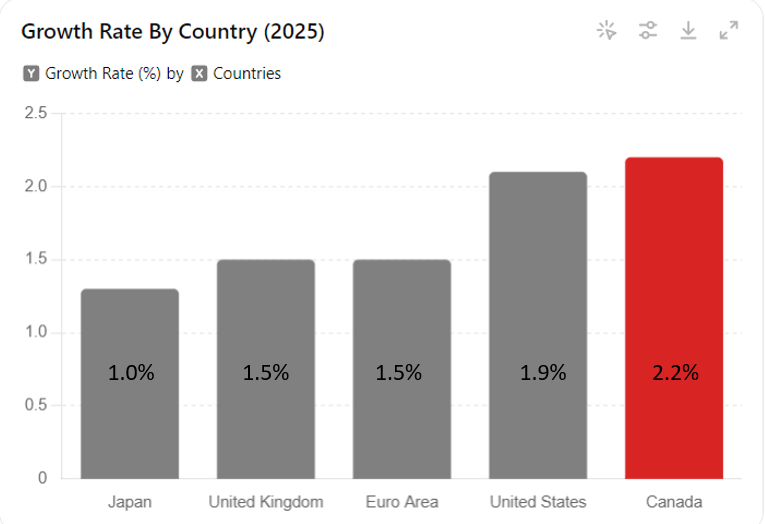
By Michael O’Neill
Canadian Liberal politicians are celebrating. The International Monetary Fund (IMF) released its World Economic Outlook update on July 17 and they are forecasting that Canada will have the fastest growing economy in the G-7 in 2025. That’s right. IMF economists are predicting Canada GDP at 2.4%, which is much better than the 1.9% GDP predicted for the US or the 1.5% forecast for the UK.
An obscure Liberal MP from Whitby, Ryan Turnbull excitedly tweeted about “never underestimating what Canadian’s are capable of or how resilient we are.” He should have added “gullible.”

Data Source: IMF
IMF Forecast Accuracy Lacking
A fellow named Jose’ M. Barrionuevo wrote an analysis for and about, the IMF’s forecasting accuracy, It was stamped “not for redistribution.” It’s easy to see why. His detailed analysis revealed persistent issues that cast doubt on the dependability of these projections.
He noted that the IMF’s ability to predict turning points in the business cycle has been notably poor, pointing out one major failure: the IMF missed signs that heralded the global financial crisis of 2008, which had far-reaching consequences for economies worldwide.
Moreover, the IMF’s forecasts have shown a tendency toward optimism, particularly in growth projections. Historical data indicates that the IMF often overestimates GDP growth rates, leading to a positive bias. The IMF’s inflation forecasts have frequently suffered from serial correlation in their errors, reducing their reliability.
Given these shortcomings, the IMF predictions should be treated like the proverbial old lady-driven used car sales pitch.
Sunny Days

The Canadian government has made a number of announcements recently that if implemented could boost economic growth in the country. The Prime Minister and the Minister of Defense are crowing about increasing military spending and even buying a new submarine fleet. On July 17, Justin Trudeau announced “the largest public transit investment in Canadian history.” It is a new $30 billion fund to expand public transit. In April, the government announced plans to build 3.87 million new homes by 2031.
Those are impressive announcements. With that amount of fiscal stimulus, the Canadian economy will be booming. But that is not going to happen. For starters, not a single penny of the $30 billion for transit will be spent before 2026, and by then, the Trudeau/Singh government will just be a memory.
NATO No-No
Mr Trudeau reacted to being chastised by NATO members for consistently failing to reach the NATO military spending commitment of 2.0% of GDP. One US Senator Dan Sullivan identified Canada as a “freeloading” NATO ally. Trudeau reacted by announcing Canada’s defense spending would reach the target by 2032. Then, Defense Minister Bill Blair followed up with an announcement that Canada would be buying 12 submarines. Of course, it is not like he placed an order or anything, but he is planning to begin the “process to engage industry on this acquisition” which is light years away from an actual purchase order. And even more ironically, he plans to buy conventionally powered submarines despite his governments’ desire to completely transition from fossil fuels.
Gloomy Days
The Trudeau governments green energy and Emissions Reduction Plan almost guarantees that Canadian economic growth will underperform that of the US. The Fraser Institutes “Economic Impact and GHG Effects of the Federal Government’s Emissions Reduction Plan through 2030” argues that it is a growth and jobs killer.

Economic Contribution of Oil
In 2022, Canada exported approximately $98.4 billion worth of oil. This figure is indicative of the sector’s critical role in bolstering the national economy, providing not only substantial revenue but also employment opportunities and regional development. The oil industry has been a cornerstone of Canada’s export market, consistently generating significant income that supports various facets of the economy. Without oil revenue, where will the money come from to support all of the government’s spending plans? “Hi-ho-hi-ho, its off the magic money tree we go.”
No Green Energy Export Revenue,
Despite governmental enthusiasm for green energy, the demand for Canadian green energy exports is minimal compared to the thriving oil sector. The export market for green energy is almost non-existent, as evidenced by the paltry $0.7 billion of green energy exports in 2022. Infrastructure and global market demand for green energy are insufficient to compensate for the potential loss in oil revenue.
Immigration Outstripping Job Creation
US and Canadian employment market comparisons are further evidence of why the IMF’s Canadian GDP growth forecast is out to lunch. In 2023, Canada’s population grew by over 1.1 million, but the country only created 632,000 new jobs. In contrast, the US population grew by 1.6 million people but the economy created 2.7 million jobs. The steep rise in the Canadian population is exacerbating an already stressed housing market, welfare and healthcare system.
Loonie Gains Will Be Unsustainable
USDCAD has not strayed from its 1.3590-1.3790 range since the middle of April. It failed to break below support despite Fed Chair Jerome Powell turning dovish, which served to negate some of the yield advantage enjoyed by US bonds compared to Canadian bonds. USDCAD tends to strengthen in the second half of the year due to companies owned by Americans repatriating profits to the head office. In days of old, high oil prices would mitigate some of the upside pressure, but that ship has sailed.
The Loonie may look like it is sitting pretty, but it is nesting on a house of cards, and Hurricane Karma has already formed.





